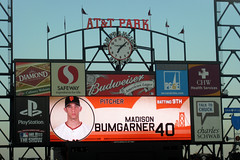You’re looking above at AT&T Park, where the World Series champion San Francisco Giants play. It’s one of the greenest stadiums in the country, writes Amanda Little in Forbes:
“[The Giants’] stadium, AT&T Park, which accommodates about 45,000 fans, runs its scoreboard on solar power, recycles and composts nearly 50 percent of its waste, sources eco-friendly napkins, containers, utensils, toilet paper and the like, and has enough efficiency features to cut the stadium’s annual energy and water bills in half. That amounts to huge savings, given that stadiums can consume as much energy as small cities.”
This is part of a trend, says Little, and I’m pleased to report that it is a trend being led in many respects by my NRDC colleague Allen Hershkowitz, who is quoted in the story.
I’ve written before in this space about green stadiums in Washington and Dublin. Nationals Park in DC (above) sports a great location and a green roof donated by the Chesapeake Bay Foundation, among other features, and was the country’s first stadium to be LEED-certified. I’ve also written about DC’s Verizon Center, whose incredible location has been a major catalyst for downtown revitalization and which draws a huge majority of its customers from the plethora of public transit lines that serve the facility. (I walked there from work Monday night to watch my Georgetown Hoyas beat Tulane; Austin Freeman dropped 23 points and Jason Clark had 17 points, 11 rebounds and five steals.) We take the arena and surrounding neighborhood vitality for granted now, but building the facility there was a brave and farsighted move by the late Abe Pollin back in the early 1990s.
 I was brought up to date on the broader subject of greening sports and entertainment by an excellent presentation of Allen’s at last week’s NRDC staff retreat. It’s been an area of focus for Allen and a few other colleagues for some time, and they have been working with a number of leagues and teams, as well as with entertainment events such as the Oscars, to improve these high-visibility businesses’ environmental performance.
I was brought up to date on the broader subject of greening sports and entertainment by an excellent presentation of Allen’s at last week’s NRDC staff retreat. It’s been an area of focus for Allen and a few other colleagues for some time, and they have been working with a number of leagues and teams, as well as with entertainment events such as the Oscars, to improve these high-visibility businesses’ environmental performance.
It’s paying off. Both Allen and Little report that sports teams are stepping up recycling and efficiency in their facilities, attracting lucrative corporate sponsorships with green messaging, and raising consciousness among fans. Other facilities mentioned in Little’s article include Boston’s Fenway Park, Atlanta’s Turner Field, and stadiums and arenas hosting the Philadelphia Eagles, Utah Jazz, Portland Trail Blazers and Phoenix Suns
Read more: http://www.greenbiz.com/blog/2010/11/19/greening-professional-sports#ixzz1ID5zSVEw
Read more: http://www.greenbiz.com/blog/2010/11/19/greening-professional-sports#ixzz1ICuSkZtV






